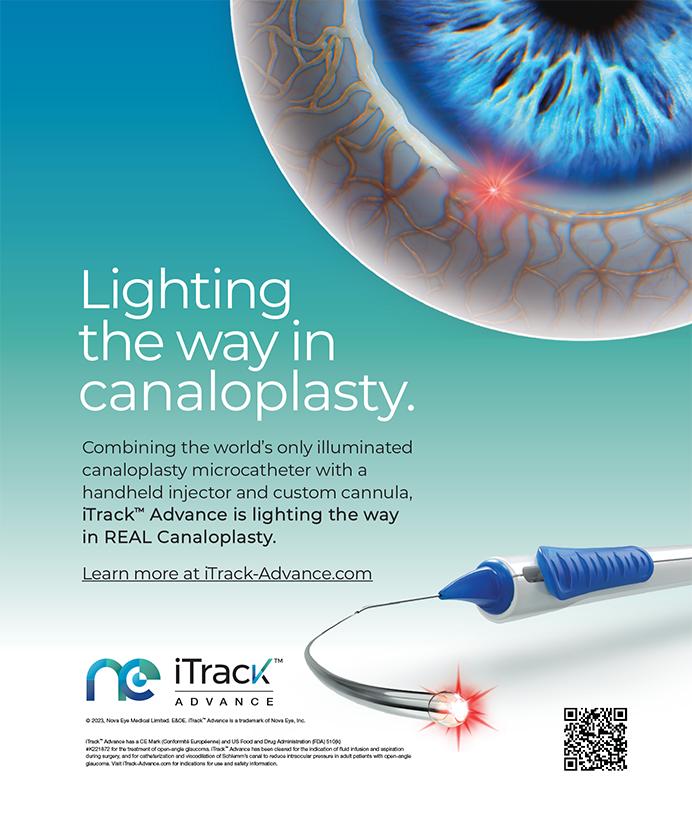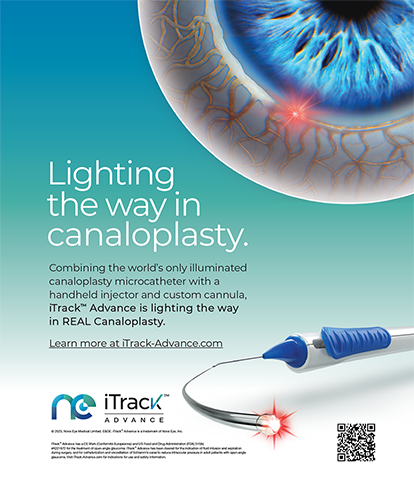CASE PRESENTATION
In 1994, a 46-year-old white male underwent bilateral RK for myopia. He subsequently presented with progressive hyperopia in the right eye. The patient's pre-RK refraction was -3.50 OD and -3.25 OS. His last examination in 1996 revealed uncorrected visual acuity (UCVA) of 20/20 OD with a manifest refraction of + 0.50, and 20/20 OS with manifest refraction plano. He complained of slight blurred vision (distance and near) in the right eye, and the vision in his left eye was satisfactory.
The patient's examination revealed UCVA of 20/50 OD and 20/25+ OS with a manifest refraction of +2.00 =20/20 and +0.50 =20/20. His keratometry readings in the right eye were 39.75/40.00 @ 5, and 41.00/41.25 @ 30 in the left eye. His scotopic pupils measured 5 mm in both eyes and his pachymetry readings were 527 µm OD, and 517 µm OS. The risk of LASIK post-RK was discussed with the patient, and he consented for surgery in right eye.
I performed the surgery in an ambulatory surgical center. Due to the patient's flat keratometry readings and need for a larger ablation zone, I used a Hansantome™ (Bausch & Lomb, Claremont, CA) 9.5-mm ring with a180-µm plate. I used a 5.5- to 9.0-mm treatment zone, and the surgery was uneventful. The RK incisions held together well without splaying open. The patient's postoperative day 1 examination revealed an UCVA of 20/60 and clear interface. He had surface dryness, which was consistent with LASIK surgery. At week 1, his UCVA was 20/20 with a manifest refraction of plano. The slit lamp examination revealed some debris in the interface inferiorly. The patient was ecstatic with the results of the procedure, and had no complaints of foreign body sensation. I placed fluorescein into the right inferior cul de sac, and there was gutter staining inferiorly at the flap edge.
HOW WOULD YOU PROCEED?1. Why would there be staining at the gutter at 1 week?
2. Is the problem merely epithelial debris or significant epithelial ingrowth?
3. If the problem is significant, would you intervene now or later? The patient is ecstatic about his 20/20 UCVA.
4. What would you tell this patient about your examination?
SURGICAL COURSE
Unfortunately, epithelial cells or debris under the flap can be a part of LASIK surgery. Intraoperative irrigation and surgical skill are the main measures of prevention. Some patients may experience undetected basement membrane disease that can cause abrasions during surgery, increasing the chance of ingrowth if the abrasion involves the flap edge. Patients who have undergone RK surgery have an increased chance of epithelial ingrowth due to the RK incisions that provide another avenue for epithelial cells to grow underneath the flap. When ingrowth is significant, the cells grow in a sheet-like manner. The cells must grow in a sheet from the epithelial surface around the flap edge and then into the interface. Once the sheet of epithelium wraps around the edge, the gutter will stain or pool with fluorescein. This staining is an important sign because the sheet of epithelium remains invisible in many significant cases. Cells that are deposited alone in the interface without a connection to the surface epithelium are rarely clinically significant.
This patient who experienced previous RK surgery, staining of the gutter inferiorly, and debris presented significant risks and signs of ingrowth without any symptoms. If this happens, the surgeon may monitor the patient weekly to observe interface changes or whether the gutter staining disappears. The patient was returned to the operating room 2 weeks post-LASIK for debridement and irrigation of the interface. Normally, I will re-elevate the whole flap and mechanically clean the bed and the backside of the flap. In this case, I was able to isolate the edge of the sheet and peel the epithelium from the back of the flap. This case was more challenging due to the patient's brittle epithelium, which was difficult to handle. His RK incisions splayed open, and he had a pie-shaped flap after the epithelium was debrided. It is prudent to use high magnification when peeling the epithelium sheet to provide visual clues as to the edges of the ingrowth. The bed and back surface of the flap were then wiped meticulously with a dry weck cel sponge. The flap was irrigated and refloated back into position. During this procedure, I would use an aspirating lid speculum. Because wrinkles of the flap are more frequent after a refloat, care must be taken to avoid this situation. The flap was stretched and allowed to dry for 5 to 7 minutes. I checked the patient under high magnification and side illumination using a hand-held light pipe. The patient was then checked at the slit lamp. He was sent to the recovery room for 30 minutes and then rechecked at the slit lamp. I placed a bandage contact lens on the eye and saw the patient later that afternoon, and again the next morning.
OUTCOME
Postoperatively, the patient's UCVA was worse on day one. His vision was 20/50 with a bandage contact lens. Because I had prepared him for this, he was not concerned when it happened. The flap was in a satisfactory position, but his epithelium had not jumped the gutter. The contact lens was left in place for another day. On day two, his UCVA improved to 20/30 and his epithelium had jumped the gutter around the flap edges and RK edges. I discontinued the use of a contact lens and placed the patient on PredForte® (Allergan, Irvine, CA), Ocuflox® (Allergan) and Celluvisc® (Allergan). At 1 week postoperatively, the patient's UCVA had returned to 20/20 and his flap interface was clear and there was no gutter staining. In retrospect, I was correct to intervene at the 2-week interval. Keep in mind that these decisions are difficult when you cannot see the epithelium and the patient has no complaints. The majority of epithelial cells resolve without intervention.


